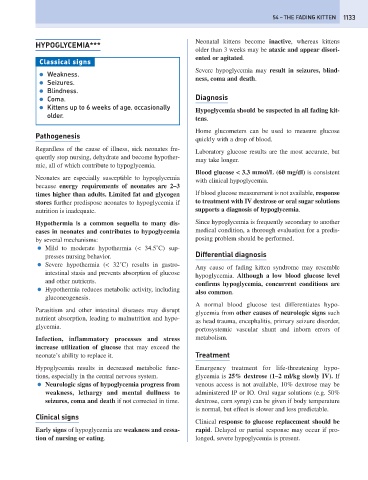Page 1141 - Problem-Based Feline Medicine
P. 1141
54 – THE FADING KITTEN 1133
Neonatal kittens become inactive, whereas kittens
HYPOGLYCEMIA***
older than 3 weeks may be ataxic and appear disori-
ented or agitated.
Classical signs
Severe hypoglycemia may result in seizures, blind-
● Weakness.
ness, coma and death.
● Seizures.
● Blindness.
● Coma. Diagnosis
● Kittens up to 6 weeks of age, occasionally
Hypoglycemia should be suspected in all fading kit-
older.
tens.
Home glucometers can be used to measure glucose
Pathogenesis
quickly with a drop of blood.
Regardless of the cause of illness, sick neonates fre-
Laboratory glucose results are the most accurate, but
quently stop nursing, dehydrate and become hypother-
may take longer.
mic, all of which contribute to hypoglycemia.
Blood glucose < 3.3 mmol/L (60 mg/dl) is consistent
Neonates are especially susceptible to hypoglycemia
with clinical hypoglycemia.
because energy requirements of neonates are 2–3
times higher than adults. Limited fat and glycogen If blood glucose measurement is not available, response
stores further predispose neonates to hypoglycemia if to treatment with IV dextrose or oral sugar solutions
nutrition is inadequate. supports a diagnosis of hypoglycemia.
Hypothermia is a common sequella to many dis- Since hypoglycemia is frequently secondary to another
eases in neonates and contributes to hypoglycemia medical condition, a thorough evaluation for a predis-
by several mechanisms: posing problem should be performed.
● Mild to moderate hypothermia (< 34.5˚C) sup-
presses nursing behavior. Differential diagnosis
● Severe hypothermia (< 32˚C) results in gastro-
Any cause of fading kitten syndrome may resemble
intestinal stasis and prevents absorption of glucose
hypoglycemia. Although a low blood glucose level
and other nutrients.
confirms hypoglycemia, concurrent conditions are
● Hypothermia reduces metabolic activity, including
also common.
gluconeogenesis.
A normal blood glucose test differentiates hypo-
Parasitism and other intestinal diseases may disrupt
glycemia from other causes of neurologic signs such
nutrient absorption, leading to malnutrition and hypo-
as head trauma, encephalitis, primary seizure disorder,
glycemia.
portosystemic vascular shunt and inborn errors of
Infection, inflammatory processes and stress metabolism.
increase utilization of glucose that may exceed the
neonate’s ability to replace it. Treatment
Hypoglycemia results in decreased metabolic func- Emergency treatment for life-threatening hypo-
tions, especially in the central nervous system. glycemia is 25% dextrose (1–2 ml/kg slowly IV). If
● Neurologic signs of hypoglycemia progress from venous access is not available, 10% dextrose may be
weakness, lethargy and mental dullness to administered IP or IO. Oral sugar solutions (e.g. 50%
seizures, coma and death if not corrected in time. dextrose, corn syrup) can be given if body temperature
is normal, but effect is slower and less predictable.
Clinical signs
Clinical response to glucose replacement should be
Early signs of hypoglycemia are weakness and cessa- rapid. Delayed or partial response may occur if pro-
tion of nursing or eating. longed, severe hypoglycemia is present.

